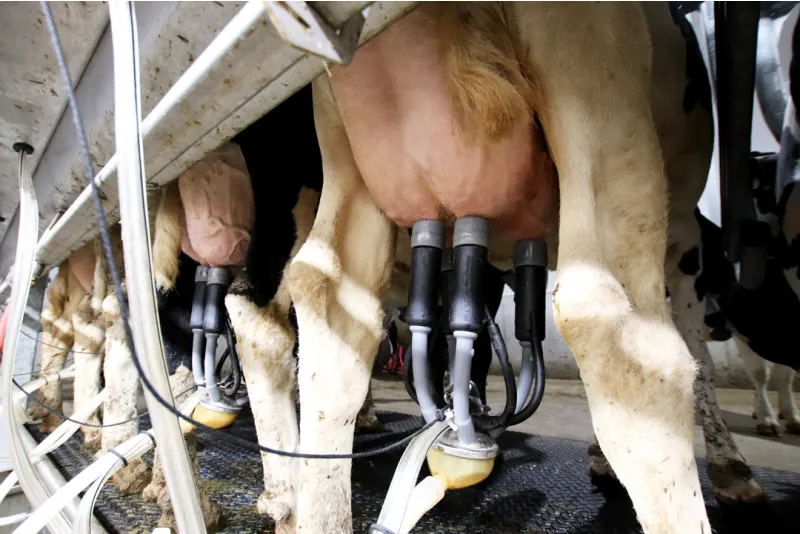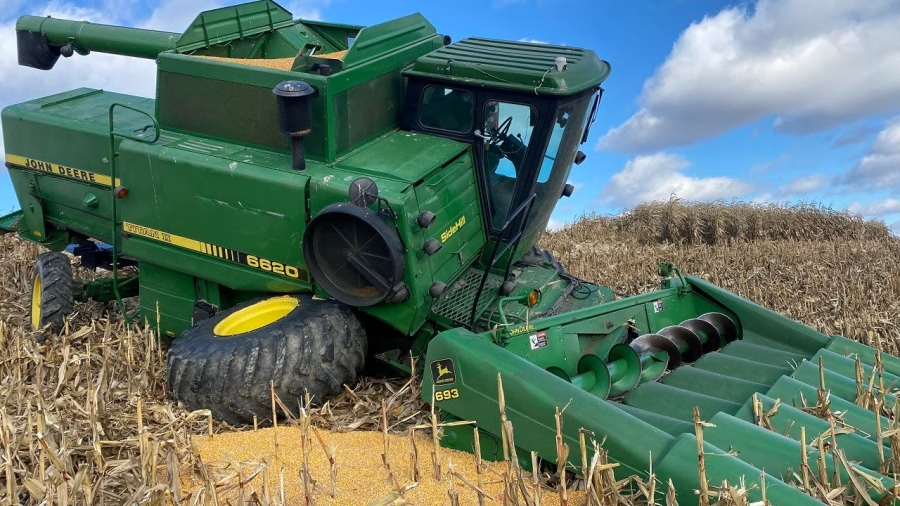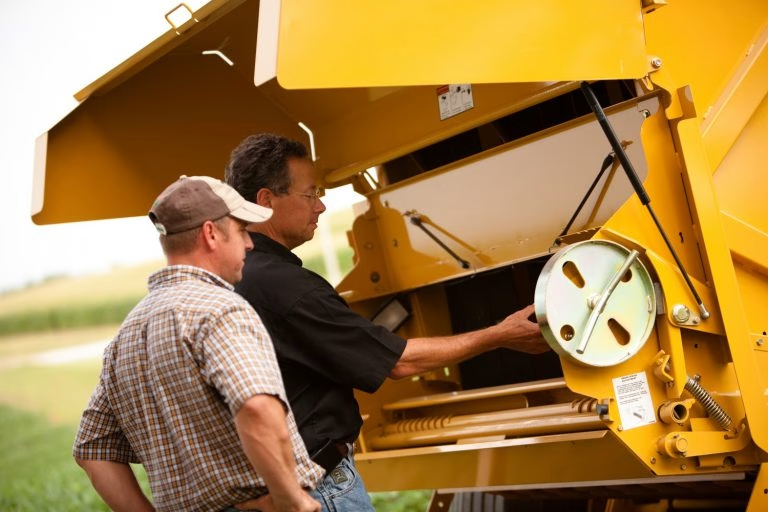Learn how proactive equipment maintenance can reduce downtime on your dairy farm. Want to keep everything running smoothly and efficiently? Find out the essential tips now.

The role of equipment in dairy farming is paramount. All machinery, from milking machines to refrigeration units, plays a crucial role in maintaining smooth and efficient operations. When your equipment is in top shape, you can maintain a steady workflow, produce high-quality milk, and grow your business. However, when equipment fails, the repercussions can be severe, leading to production delays, milk spoilage, and costly repairs.
Imagine a critical machine breaking down unexpectedly. Production delays, milk spoilage, and costly repairs can quickly follow. Extended downtime means financial losses and strained client relationships.
“An hour of prevention is worth a day of cure. In dairy farming, proactive equipment maintenance saves time and significant money.”
Proactive equipment maintenance is crucial to avoiding these pitfalls. This article will explain the benefits of staying ahead of breakdowns and offer practical tips for keeping your equipment in top condition.
Unlock the Power of Proactive Maintenance for Dairy Farm Success
Understanding proactive maintenance is vital for any dairy farmer aiming for consistent and efficient operations. Proactive maintenance means regular and planned servicing of equipment to avoid unexpected breakdowns. Instead of fixing things only when they break, you routinely inspect, clean, adjust, and replace parts based on performance data. This knowledge empowers you to take control of your equipment’s health.
Here’s why proactive maintenance is beneficial:
- Longer Equipment Life: Regular servicing prevents premature wear and tear.
- Less Downtime: Scheduled maintenance keeps equipment running when you need it.
- Cost Savings: Routine checks save money by avoiding expensive repairs.
- Better Efficiency: Well-maintained equipment performs better and uses less energy.
- Increased Safety: Regular checks catch hazards early, keeping everyone safe.
Proactive maintenance is all about prevention. It’s an investment in reliability and sustainability, ensuring your equipment stays in top shape all year round. This approach instills a sense of security, knowing that you’re prepared for any potential issues.
Essential Tools for Smooth Dairy Operations
Dairy farming relies on crucial equipment to ensure efficiency and productivity. Knowing these tools is essential for smooth operations:
Milking Machines
These are core to dairy farming. They automate the milking process to save labor and time. They ensure thorough and hygienic milking, protecting milk quality and cow health. Routine maintenance is crucial to prevent breakdowns and costly delays.
Cooling Systems
This equipment preserves milk quality by quickly lowering its temperature after milking, preventing bacterial growth. Regular service checks are essential to keep these systems working efficiently.
Feeding Equipment
Automated feeders provide consistent, balanced diets, directly affecting milk production and herd health. Maintaining these systems ensures your cows get the nutrients they need without interruption.
Proactive maintenance of these essential tools boosts productivity. It helps you avoid unexpected disruptions, saving time and money in the long run.
Reap the Rewards of Proactive Equipment Maintenance
Proactive maintenance offers numerous benefits that significantly improve your dairy farm’s operations.
Reduced Downtime: Regular maintenance keeps machinery in top working condition, reducing unexpected breakdowns. You avoid interruptions during peak times by consistently inspecting your milking parlors, ensuring smooth milk production.
Extended Equipment Lifespan: Routine upkeep prolongs the life of your equipment. For example, maintaining pasteurization machines means you won’t need replacements as often, saving money in the long term.
Proactive Maintenance is not just a theory; it’s a proven strategy. A dairy farm in Wisconsin saw a 15% increase in operational efficiency and lower energy costs after a year of proactive maintenance. This is a tangible example of how regular servicing can improve your dairy operations’ efficiency and save you money in the long run.
Investing in proactive maintenance ensures your dairy farm runs smoothly and cost-effectively.
Develop an Effective Maintenance Schedule for Uninterrupted Dairy Operations
Developing an adequate maintenance schedule is critical to uninterrupted dairy farm operations. Here’s how:
- Assess Your Equipment: List all regularly used equipment, from milking machines to pasteurization units.
- Set Priorities: Identify critical equipment that would cause significant disruptions if it fails. Less crucial items can be inspected less frequently.
- Establish Maintenance Intervals: Based on manufacturer recommendations and your farm’s specifics, determine how often each piece needs maintenance.
- Create a Maintenance Calendar: Plan monthly, quarterly, and annual tasks. A visual calendar helps ensure that no task is missed and that the workload is balanced.
- Use Tracking Tools: Log activities using software or a spreadsheet: record dates, tasks, and anomalies to aid future planning and troubleshooting.
- Conduct Regular Inspections: Routine inspections are vital. Regular checks catch problems early, preventing significant disruptions.
- Review and Adjust: Continuously review and tweak your maintenance schedule. Gather feedback from staff on emerging issues that need attention.
These steps keep your dairy farm running smoothly, minimizing unexpected breakdowns and maintaining high productivity. A proactive maintenance approach safeguards your assets and boosts operational efficiency. Successfully implementing and sticking to a maintenance schedule is a testament to your dedication and hard work, bringing a sense of accomplishment.
Knowledge is Power: Invest in Your Team’s Training and Education
Training and education are crucial for smooth dairy farm operations. Educating your staff on equipment use and maintenance ensures everything runs smoothly. Well-informed employees can spot signs of wear and tear, preventing significant mishaps.
Leverage resources like online courses, workshops, and manufacturer-provided training sessions. Many manufacturers offer detailed manuals and video tutorials for continuous learning. Platforms like Dairy Management Inc. and The Dairy Learning Center also provide excellent training materials for dairy farm needs.
Knowledgeable employees are your first defense against equipment breakdowns. Encourage regular training and hands-on practice. A well-trained team boosts productivity and extends the lifespan of your equipment, ensuring long-term farm success.
Embrace Cutting-Edge Technology for Proactive Maintenance
Modern technology has made proactive maintenance more accessible and more effective. Essential tools like sensors and predictive analytics are at the forefront of this change.
Sensors: These devices are installed on equipment to continuously monitor parameters like temperature, vibration, and pressure. By doing so, they can detect anomalies indicating possible issues, such as temperature spike signaling bearing troubles. This early warning allows you to address problems before a breakdown happens.
Predictive Analytics: This technology uses sensor data and algorithms to forecast potential equipment failures. It identifies patterns and provides insights. Imagine getting a notification that a component might fail in 100 hours. This info lets you plan maintenance during scheduled downtime, reducing disruptions and extending equipment life.
These technologies keep you ahead of potential issues, ensuring smooth and efficient dairy operations. Investing in them optimizes maintenance, protects your assets, and boosts productivity.
Proactive Maintenance vs. Unexpected Breakdowns: A Cost-Benefit Analysis
| Maintenance Type | Average Annual Cost | Average Annual Downtime | Long-term Equipment Lifespan Increase |
|---|---|---|---|
| Proactive Maintenance | $10,000 | 10 hours | 20% |
| Reactive Maintenance | $15,000 | 50 hours | 5% |
Comparing proactive maintenance to unexpected breakdowns reveals clear advantages. Proactive maintenance involves regular check-ups and minor repairs to keep your equipment running smoothly. Although there’s a cost for labor and parts, it’s far less than the expenses from sudden breakdowns, which can lead to costly repairs, downtime, and lost productivity.
Unplanned repairs are expensive, with emergency services and sudden part replacements adding up. Proactive maintenance, however, spreads these costs over time, making them easier to manage within your budget.
Potential Savings:
- Repair Costs: Routine maintenance reduces wear and tear, cutting repair expenses by up to 50% compared to reactive fixes.
- Reduced Downtime: Unexpected breakdowns can halt your operations. Proactive maintenance can decrease downtime by up to 30%, keeping your farm running smoothly.
Increased Productivity: Well-maintained equipment means peak performance, possibly boosting productivity by 10-15%, ensuring you meet production targets.
Investing in proactive maintenance protects your assets, extends equipment life, and aligns with sustainable farming practices, maximizing your return on investment.
The Bottom Line
Proactive maintenance is vital for your dairy farm’s success. By using essential tools, sticking to a maintenance schedule, and investing in team education, you’ll significantly reduce unexpected breakdowns. Embrace technology and understand the financial benefits to underscore its importance. Act now to protect your assets, cut costs, and boost efficiency. Assess your current practices and pinpoint areas for improvement. Remember, a little proactive care now can save you from significant disruptions later.
Key Takeaways:
- Minimizes unexpected breakdowns and operational interruptions.
- Extends the lifespan of your equipment, reducing long-term costs.
- Enhances the efficiency and performance of dairy equipment.
- Saves on energy costs due to well-maintained machinery using less power.
- Enables early detection of potential hazards, ensuring farm safety.
- Boosts overall productivity and profitability for your dairy farm.
Summary:
Dairy farming relies heavily on the maintenance of equipment like milking machines and refrigeration units to ensure smooth operations. Failure of these machinery can lead to production delays, milk spoilage, and costly repairs. Proactive maintenance is crucial for dairy farmers to prevent unexpected breakdowns and maintain equipment health. Regular servicing prevents premature wear and tear, reduces downtime, and saves costs by avoiding expensive repairs. Well-maintained equipment performs better and uses less energy, while early checks catch hazards. Essential tools for smooth dairy operations include milking machines, cooling systems, and feeding equipment. Proactive maintenance boosts productivity and prevents unexpected disruptions, saving time and money in the long run. A dairy farm in Wisconsin saw a 15% increase in operational efficiency and lower energy costs after a year of proactive maintenance.














